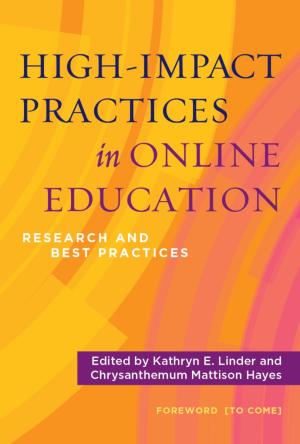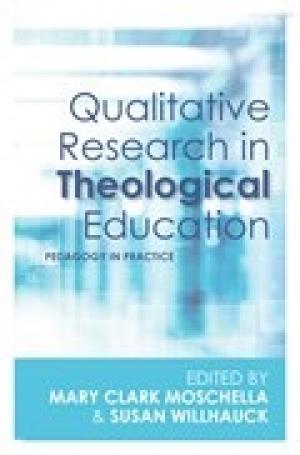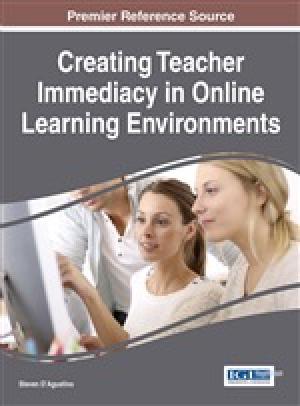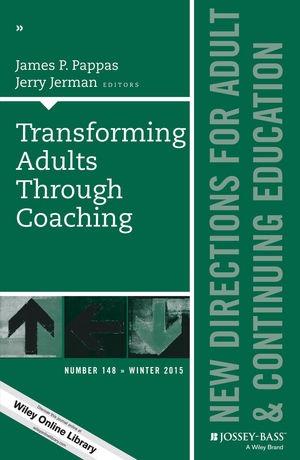Resources by Gary S. Eller

What are the potential benefits of high-impact practices (HIPs) for online education? That is the key question addressed in this well-researched collection of essays. Whether the reader is new to innovative theory and techniques in online education or an experienced distance educator, they will find a valuable resource here. Each contributor provides a helpful short list of key takeaways and a solid bibliography at the end of their chapter. The introduction and conclusion by the editors, Linder and Hayes, set the framework for the discussion and aptly describe possible future directions for teaching online, blended, or face-to-face courses. High-Impact Practices in Online Education reads like a dynamic conversation on research with practical recommendations for how to strengthen a variety of teaching contexts. Each topic selected for inclusion covers a specific high-impact educational practice. That list was largely identified in 2008 by George D. Kuh as ten critical components of undergraduate education. First-year seminars, learning communities (LCs), writing-intensive courses, and internships were among those featured components. These practices are still considered high-impact, but newer practices, such as ePortfolios, have been added in subsequent years. All have become part of developing educational strategies to impact student retention and graduation rates. So, where will readers find what they most need in this collection? For some, a particular topic will draw their attention. My suggestion is to resist that impulse. Try, instead, reading the introduction and conclusion before sampling individual chapters. Understanding the context for the conversation about HIPs matters. The research and literature in this emerging field has been somewhat scattered, but a representative sample is nicely gathered and incorporated into this single volume. There are no chapters specifically on theological education or religious studies. That said, there is much of worth to educators in those disciplines. For example, June Griffin’s “Writing-Intensive Classes” or Pamela D. Pike’s “Internships” speak directly to theological and religious educators. The same can be said about Stefanie Buck’s “High Impact Practices and Library and Information Resources.” No doubt other readers will discover other favorites as well. Remember that any one of these chapters could make a dramatic difference in most teaching and student learning. Is there one overarching idea offered as a takeaway? Yes, and it is that best practice principles are, in the end, more important than modalities. That is a valuable point to have in mind as exciting new technologies continue to emerge.

If you are looking for a current collection of essays about the state of qualitative research in theological education, then this volume edited by Moschella and Willhauck will be extraordinarily useful. The contributors offer a broad-based, international approach to their topic, complete with case studies and a select bibliography. Together, they argue that qualitative research is essential to the formation of ministers and theological scholars. Moschella’s introduction provides a concise overview of how this collaborative project began, key themes in the field of ethnographic studies, and how each of the essays addresses these issues. There is real value here for the reader who is just plunging into the study of qualitative research and needs an overview of how the discipline is developing. This is a handbook in four parts, with fifteen chapters. As such, it is designed for both reading and reference. In addition to the introduction, most readers will benefit from the first two entries that comprise Part One, “Exemplary Research Essays.” Whitmore’s essay, “Theology as Playbook and Gamefilm: Explaining an Ethnographic Approach to Theology to a Sports-Centred Culture,” uses sports analogies to underscore the vital connection between theology and practice. This is one of several essays that emphasize the theological nature of ethnographic research. For theological educators, this is an important contention which broadens the discussion beyond contrasting qualitative versus quantitative methods and goals. Just how inclusive that discussion can become is indicated by Sorajjakool and Prachyapruit in “Qualitative Methodology and Pedagogy: A Study of the Lived Experiences of Thai Peasants within the Context of Western Development Ideology.” Part Two, “Issues in Education and the Practice of Research,” includes ten chapters that emphasize the embodied and contextual nature of qualitative research. They are also a reminder that the interdisciplinary nature of this work is a necessary and fitting response to the complexity and messiness of real life. While there are several strong essays in this group, particular note should be taken of “Promoting the Good: Ethical and Methodological Considerations in Practical Theological Research” by Graham and Llewellyn, along with “Just Don’t Call It ‘Ethnography’: A Critical Ethnographic Pedagogy for Transformative Theological Education” by Wigg-Stevenson. Part Three, “Integrating Qualitative Research into Theological Education”, includes Mellott’s “Qualitative Research in Theological Curricula” and Clarke’s “Wonder and the Diving Dance: The Lived Reality of Qualitative Research within a Master of Divinity Curriculum.” Both essays are valuable for theological educators and will repay rereading. The concluding section, Part Four, “Valediction,” is a single essay by Willhauck, “The Gift and Challenge of Qualitative Methods for Pastoral Formation.” Four major themes for teaching qualitative research are identified and briefly discussed including: contextualization, communication, reflection/reflexivity, and vocation (264). Willhauck’s elaboration on these themes makes a fitting conclusion to this extraordinarily rich and suggestive resource.

A key issue in distance education is how to establish a vital two-way, personal communication between learner and instructor. Borje Holmberg, among other theorists, argues that the primary role of an instructor is to empathize with the learner; imparting information is a secondary matter. What, then, are the most effective ways to form a dyadic alliance between a learner and instructor? This is the major question that D’Agustino’s Creating Teacher Intimacy in Online Learning Environments seeks to answer. This is a reference work, so it can be read profitably article by article or completely. The volume begins with a helpful detailed table of contents that provides a brief synopsis of each chapter. There is also a useful foreword by Karen P. Kaun which underscores the importance of the human component in teaching and learning regardless of the instructional format. The preface speaks to the impact of the “interactive turn,” the “undesigned remainder,” and the “modelling function” in asynchronous learning. In addition, there is a brief description of each chapter that complements the summaries in the table of contents. Every chapter also starts with an abstract and an introduction. Pedagogy, not technology, is the focus of each chapter. Therefore, this reference is valuable for course designers, media specialists, instructors, and researchers across a range of academic disciplines. That said, there are a few chapters that all will want to read and ponder. Oliver Dreon’s “Building Teaching Presence in Online Classes,” for example, provides an overview of the main issues along with strategies that support learning and interaction. A list of design principles is included, suggestions for future research are indicated, and there is a concise paragraph of conclusions plus an extensive list of references. A central contention made by Dreon is that practices that contribute to high quality, traditional undergraduate instruction also apply to establishing meaningful instructor presence in online classes. Many readers will also want to look closely at Caroline M. Crawford’s “Instructor Immediacy and Authenticity: Engaging in Cognitive Vulnerability within the Instructional Environment.” Often, learner success in an online course – synchronous or asynchronous – will largely depend on the instructor’s efforts to generate worthwhile interactive opportunities. These activities require that the instructor have a clear philosophical belief system united with an understanding of the learner’s cognitive vulnerability in an online environment. Crawford explores these core issues while calling for the development of a “talent propelled” instructional environment. Neal Shambaugh’s “Interactivity and Immediacy in Online Academic Programs” addresses quality issues in higher education distance classes. This is an important theme because, as D’Agustino notes in the preface, “online learning still has a perceived lack of legitimacy” (xxiv). Shambaugh advocates interactivity as a method to counter this concern. He offers a list of best practices for creating and sustaining online immediacy. Then he sketches a series of recommendations for undergraduate, master’s, doctoral, and specialized programs, such as teacher education, certificates, and professional development. There is an extensive compilation of references and notes about the contributors that conclude this collection. The references alone are an excellent guide for further research and course syllabi.

Transforming Adults Through Coaching (New Directions for Adult and Continuing Education, Number 148)
Coaching has grown exponentially as a professional practice and as a discipline in recent years. According to the International Coach Federation (ICF), the number of coaches worldwide increased from some 30,000 in 2008 to 47,000 in 2012. Coaches assist individuals with a variety of vocational and personal issues in both public and private sector organizations. As a result, many clients have become better prepared to reach their workplace and life goals. The field of adult coaching as a discipline has matured considerably alongside the practice itself. For example, studies of best coaching practices and analysis of coaching models abound. Professional organizations have formed and have begun to address such critical issues as training, certification, and ethical standards. Transforming Adults Through Coaching, edited by Pappas and Jerman, provides an introduction to the history, current practices, and possible future of coaching. Each chapter in this compact overview includes material that will benefit scholars, practitioners, and their clients. In particular, there is a solid review of adult development and learning theory with illustrative case studies and pertinent bibliographies. Pappas and Jerman acknowledge in their introduction that clarity is needed when considering what coaching is and is not. It is, they say, neither psychotherapy nor advice giving. Coaching is relational. It is ordinarily practiced with individuals and not groups. And, they underscore, the coaching relationship typically proceeds with a combination of questions and attentive listening. The results, they contend, can be transformative for clients. The first three chapters sketch the parameters for the field of adult coaching. The initial essay by Rachel Ciporen is “The Emerging Field of Executive and Organizational Coaching: An Overview.” Ciporen provides the reader with essential definitions and perspectives on coaching as well as a valuable list of resources for further study. She also notes some of the most common critiques of coaching, such as a frequent reliance on an “overly simplistic view of the learning and change process” (12). Carolyn Coughlin explores a major goal of adult coaching in “Development Coaching to Support the Transition to Self-Authorship.” Her essay describes how coaches, using their knowledge of adult development – especially body and mind theory and practice – can facilitate their client’s movement toward self-authorship. Adult learning theory provides a vital foundation for coaching. Elaine Cox’s contribution, “Coaching and Adult Learning: Theory and Practice,” identifies links between andragogy and transformative learning and how each connects with the practice of coaching. In addition, Cox addresses practical applications of these theories. Brief illustrative dialogues are included to show how the theories can impact actual adult coaching. “Coaching as a Strategy for Helping Adults” by Dorothy M. Wax and Judith Westheim focuses on the kind of issues adult learners bring to the learning environment and how coaching strategies can help them deal with professional and personal obstacles to success. Pappas and Jerman’s closing essay, “The Future of Coaching among Adult Populations,” outlines major directions and critical issues that lie ahead for the field. They underscore not only continued growth for coaching, but also the need for further refinements, including more specialization. These are some of the essays that make this brief collection valuable, not only for coaches and their clients, but for a range of helping professionals and researchers.

Distance education is a growing component of higher education. Whether students combine distance courses with traditional classroom hours or focus entirely on distance learning, the presence of distance education in major colleges and universities in America continues to expand. Hybrid courses, which combine face-to-face learning with a digital component, are becoming very popular options for students. Most college graduates in the class of 2020, for example, will have received some of their credit hours online. The essays collected by Maureen Snow Andrade for Issues in Distance Education address each of these phenomena and more. The initial essay, “Issues in Distance Education: A Primer for Higher Education Decision Makers” by Michael Beaudoin, provides an overview of the development of distance learning in higher education. This is a very useful chapter, particularly for administrators and prospective instructors who are looking for a short introduction to how distance education became such a prominent feature of American higher education and some of the resistance it has encountered. Beaudoin refers to distance learning as a disruptive technology, which is an apt description of the kind of impact it has had on administrators, faculty, and students. Disruptive technology requires transformative leadership in order to make the best use of what is logistically possible. Farhad Saba’s discussion, “Theories of Distance Education: Why They Matter,” analyzes various theories of distance learning and links the theories to future institutional policies and practices. Saba advocates a community of inquiry model that combines a social, cognitive, and teaching presence that makes the best use of new technologies and flexible learning schedules. Andrade’s essay, “Effective Organizational Structures and Processes: Addressing Issues of Change,” explores both macro and micro level structural models for distance education. She proposes four interconnected leadership frameworks for both creating and managing change. The strengths and weaknesses of each model, such as environmental and stakeholder issues, are also discussed along with a set of guiding questions for institutional change. These first three essays provide a core of information and key questions that will serve readers well. Each of the six chapters which follow focuses on a related issue that the initial essays prompt. For instance, how can a development plan contribute to course consistency and quality? Is a team approach to course development desirable? What sort of faculty support is essential for high level learning outcomes? How can distance learning be successfully offered on a global scale? What sort of strategic planning will facilitate all of this? This compact volume does not attempt to settle all of the issues that it raises. It does provide an excellent starting point for discussions about innovative methods for teaching theology and religion as well as the attendant policies, costs, infrastructure, and support necessary to sustain them.